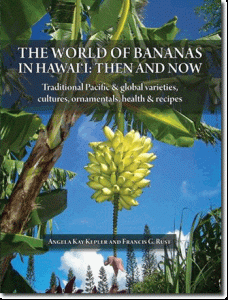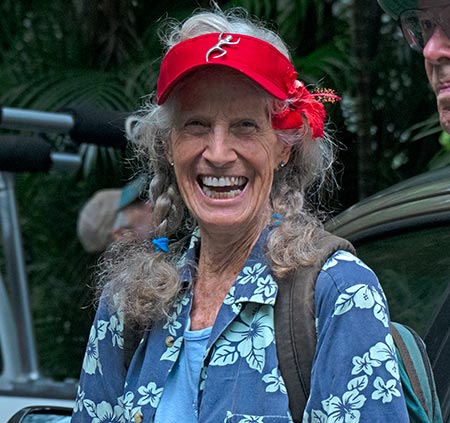By Dr. Angela Kepler and Francis Rust
Review by Olin Erickson – Mauiscapes
A few words of introduction cannot begin to describe the wealth of information found in this book. It begins with the amazing seafaring migrations of pacific islanders who brought banana varieties (mai’a in Hawaiian) with them. Over time the mai’a evolved into distinct Hawaiian varieties. There is an extensive discussion of the origins, habitat, propagation and uses of all distinct varieties complete with pictures plants legends and folklore. These Hawaiian Mai’a especially when cooked are known to be the tastiest bananas on earth. It is no wonder that Angela and Francis proclaim that their staple carbohydrate is the traditional Hawaiian bananas. They even provide the recipes they use for cooking and serving bananas.
- Banana’s originate in Southeast Asia.
- They are rich in vitamin C and Potassium.
- Hawaii has had over 100 varieties of banana’s, including edible, inedible and ornamental varieties.
- “Mai’a” – Hawaiian for “banana”
- “Hina’ea” – Hawaiian goddess of the banana.
- Circa 1350 pacific travelers introduced “canoe plants” that included the pacific plantains and pacific bananas that we are familiar with today.
- Canoe banana’s are polynesian heirlooms, they have been very important to Hawaiian culture. One variety in particular is the “Mai’a Maoli” which is common to the west Maui mountains.
- Pacific plantains include 3 main varieties; Maia Maoli, Maia Pop’ulu & Maia Iholena.
- Mai’a Maoli – Large sausage like fruit, plants can be found in the EMI areas of Maui.
- Mai’a Pop’ulu – Short fat fruit, good cooking banana.
- Mai’a Ihalena – Extremely rare, very beau- tiful, Large fruit & Dark leaf, Lots of Keiki, short stature, wind resistant.
- Circa 1820 polynesians introduced the Pacific Fei & Maia Hapi varieties.
- Mai’a Fei – Upright bunches, good cooking banana
- Mai’a Hapi – “pregnant banana”, very sweet & a good dessert banana, bunch emerges from within the stock.
Of the 100 Hawaiian varieties that have been recorded many of them are dwindling away. Since 1990, 17-20 species are extinct or most likely extinct. 14 + species are critically endangered, up to 100 plants state wide. Most of the Hawaiian bananas are endangered, 500-2500 plants.
40 species are currently present of the original 100+ varieties of Hawaiian banana’s, 19 species are still present and living in our natural habitat.
We are losing our precious Hawaiian banana strains to: neglect, invasive plants, development, disease, bugs and lack of education! At the rate things are going, we will not have any Hawaiian banana’s left in the wilderness in the next 10-20 years! Together we can all work together to prevent the loss of this important staple and part of polynesian culture.
Common NON- Hawaiian banana varieties growing today:
- Dwarf Brazilian – Good variety to grow, short stock
- Ice cream – Sweet tasting, short stock 10-15′
- Cuban & Dwarf Red – Good tasting banana
Proper Banana plant care:
- Keep your banana clumps free of grass and weeds growing around and inside of the clump. Use mulch to help keep weeds down and promote
healthy soil and healthy keiki (new sprouts). - Cut down old stocks and use leaves for mulch, dispose of the stock. Inspect plants for insects, fungus and viruses. Remove any infected leaves and dispose of properly.
- Organic fertilizer are best for banana’s. It is typical for banana’s to have calcium and boron deficiencies. Solutions: Add dolomite & 1-2 tsp of borax per plant.
Varieties to Avoid!:
- Chinese Banana – Tends to attract Bunchy Top Virus
Pest & Diseases:
- Corm Weevils – A bug/pest problem. They bury into corms underground and jeopardize the structure of the clump. Symptoms will always include black hole signs inside the stock.
- Black Sigatoka – A fungal problem. This disease destroys the banana leaves and crop yields can be significantly reduced. Hard to control can use fungicides, disease resistant varieties are being bred. Some varieties are more resistant than others.
- Banana Bunchy Top Virus – A virus problem that is not curable!!
Signs of virus will include:, “J” – Hooks near the mid-rib of the leaf. Normal veins should be white Infected veins will be green & “dotted”.
Prominent in Pukalani & Kihei!!!
Spread by infected Aphids & Humans. Do not transport infected material, Report to MISC and follow proper handling procedures.


